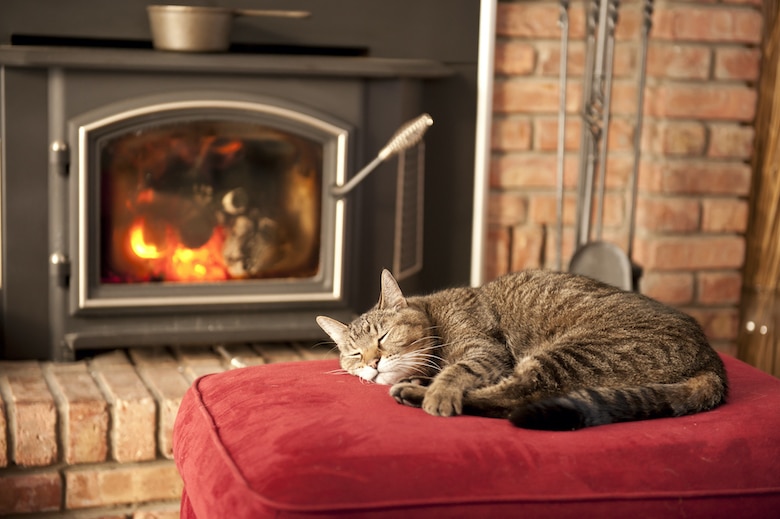How to Keep Kitty Safe Around the Fireplace
The post How to Keep Kitty Safe Around the Fireplace by Sassafras Lowrey appeared first on Catster. Copying over entire articles infringes on copyright laws. You may not be aware of it, but all of these articles were assigned, contracted and paid for, so they aren't considered public domain. However, we appreciate that you like the article and would love it if you continued sharing just the first paragraph of an article, then linking out to the rest of the piece on Catster.com.
Fall weather is here and most of us are enjoying cozy evenings at home. If you have a woodstove or fireplace in your home you probably have been cuddling up by the fire with your cat, but is it safe? Unfortunately, as much as we like fireplaces, so do cats, sometimes a little bit too much.
Wood-burning fireplace safety concerns
Dr. Jamie Richardson, Medical Chief of Staff at Small Door Veterinary explains that “a major safety concern with wood-burning fireplaces is that the top surface or hood can often get very hot.”
Because cats have a tendency to seek out warm areas, Dr. Richardson notes that cats may be enticed by warm surfaces and try to jump onto the fireplace, which can lead to burned paws.
Sharon Cooksey, Kidde Fire Safety Educator with Kiddee Fire Safety advises that the most important safety precaution you can take is to always supervise your cat when your fireplace is lit, and to keep your cat away from the fireplace. “Fireplaces can spark and ignite items nearby, plus fire screens, gates and tools can become hot to the touch. Keep bedding at a safe distance too” Sharon says.

An old tabby cat soaks up the heat in front of a wood burning stove. Photo: Westhoff/Getty Images
Fireplace safety tips for cats
To keep cats safe with a fireplace in your home it’s a good idea to utilize a glass door if your fireplace has one as well as metal fireplace screens to keep cats a safe distance from the fireplace. Sharon encourages cat guardians to “consider installing a baby gate to help keep at least a 3-foot safety zone surrounding your fireplace and keep all fire tools, such as pokers, kindling, lighters and fluids, behind the pet barrier to keep them away from easy access.”
To keep kitty happy Dr. Richardson suggests you “set up your cat’s favorite bed close enough to the fireplace where they can feel the warmth they tend to seek out, but at a safe enough distance to keep them out of harm’s way.” This will protect your cat from direct burns from jumping onto/into the fireplace, and also prevent the risk of flying embers from the fireplace which could also lead to injuries.
During the autumn and winter holiday season, it can seem tempting to decorate on your mantel; however, “garland and tinsel type decorations can be particularly tempting for curious cats, so I would recommend avoiding these types of decorations in cat households, as they may lure a cat close to the dangers of the fireplace,” Dr. Richardson advises.
Carbon monoxide risks
In addition to the risk of burns from fireplaces, “fireplaces can also be a source of carbon monoxide, which can affect pet owners, as well as their furry companions, through carbon monoxide poisoning,” Sharon says.
Carbon monoxide is odorless, tasteless and colorless, which makes this gas extremely dangerous.
To help prevent issues with carbon monoxide in your home, Dr. Richardson advises, “It is imperative for all homes with a working fireplace to ensure they are cleaned and maintained regularly, the flue and damper are always open and to have working carbon monoxide alarms in the home to avoid the risk of poisoning in both humans and pets.”
Symptoms
If there is carbon monoxide in the home, pets and humans will experience similar symptoms, which Dr. Richardson describes often starts with dizziness or lack of coordination and rapidly progress to drowsiness, difficulty breathing and ultimately loss of consciousness.
Cats may also begin vomiting or have difficulty breathing. Other symptoms to watch for include:
- Sleepiness or lethargy
- Uncoordinated movement
- Disturbances in gait
- Seizures
- Heart arrhythmia
- Coughing
- Deafness
- Blindness
- Coma
Treatment
If you suspect that there is a carbon monoxide problem in your home, immediately get your cat and all other members of your family out of the home and call 911. Then contact your local veterinary hospital or poison control. Sharon says that “veterinarians may not immediately suspect CO poisoning so if you believe your pet has been exposed, consider asking for CO toxicity evaluation. This may be done by a blood test.”
Prevention
Just like keeping your cat away from your fireplace with supervision and gates/barriers is the best way to prevent burns, the best way to prevent carbon monoxide poisoning is through prevention. It is best to have your fireplace chimney professionally cleaned/swept annually and carbon monoxide alarms should be placed through your home. Alarms should be placed at least one on every level, including in/near bedrooms. Test your carbon monoxide alarms regularly to make sure they are working properly and follow manufacturer suggestions for how often to replace, usually every seven to 10 years.
Read Next: How to Make Sure Your Cat is Comfortable This Holiday Season
The post How to Keep Kitty Safe Around the Fireplace by Sassafras Lowrey appeared first on Catster. Copying over entire articles infringes on copyright laws. You may not be aware of it, but all of these articles were assigned, contracted and paid for, so they aren't considered public domain. However, we appreciate that you like the article and would love it if you continued sharing just the first paragraph of an article, then linking out to the rest of the piece on Catster.com.




Post a Comment